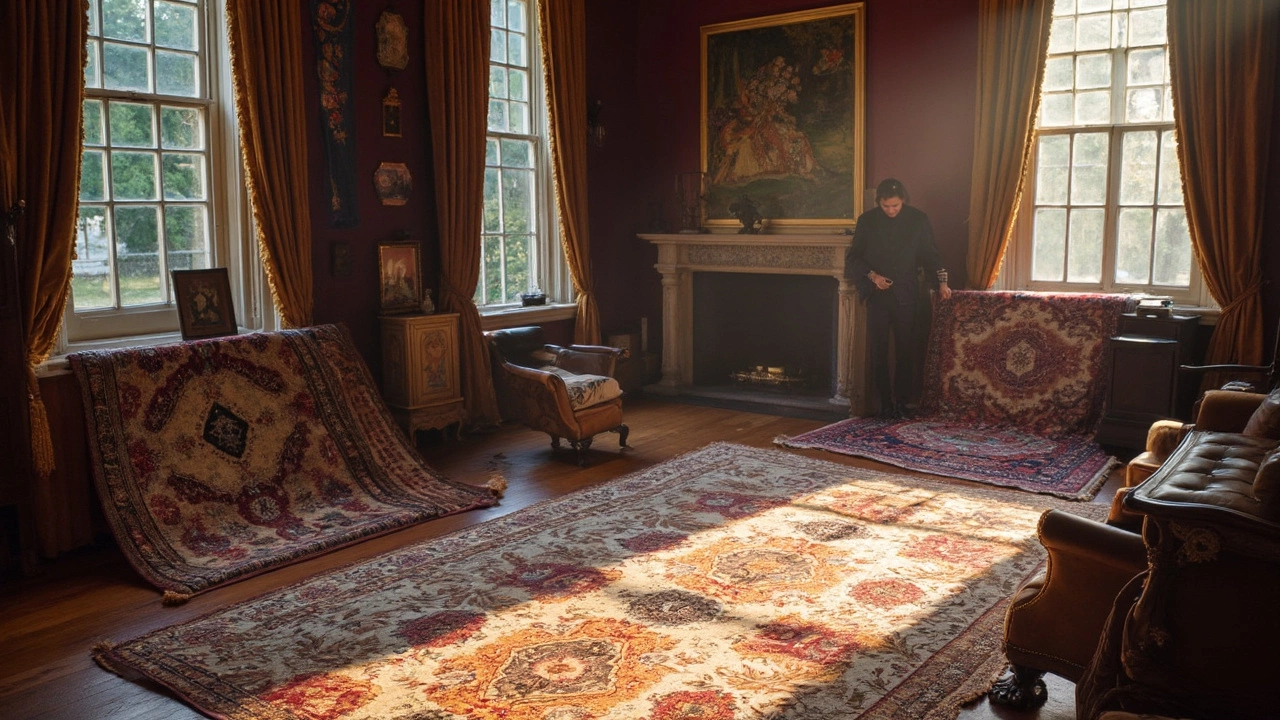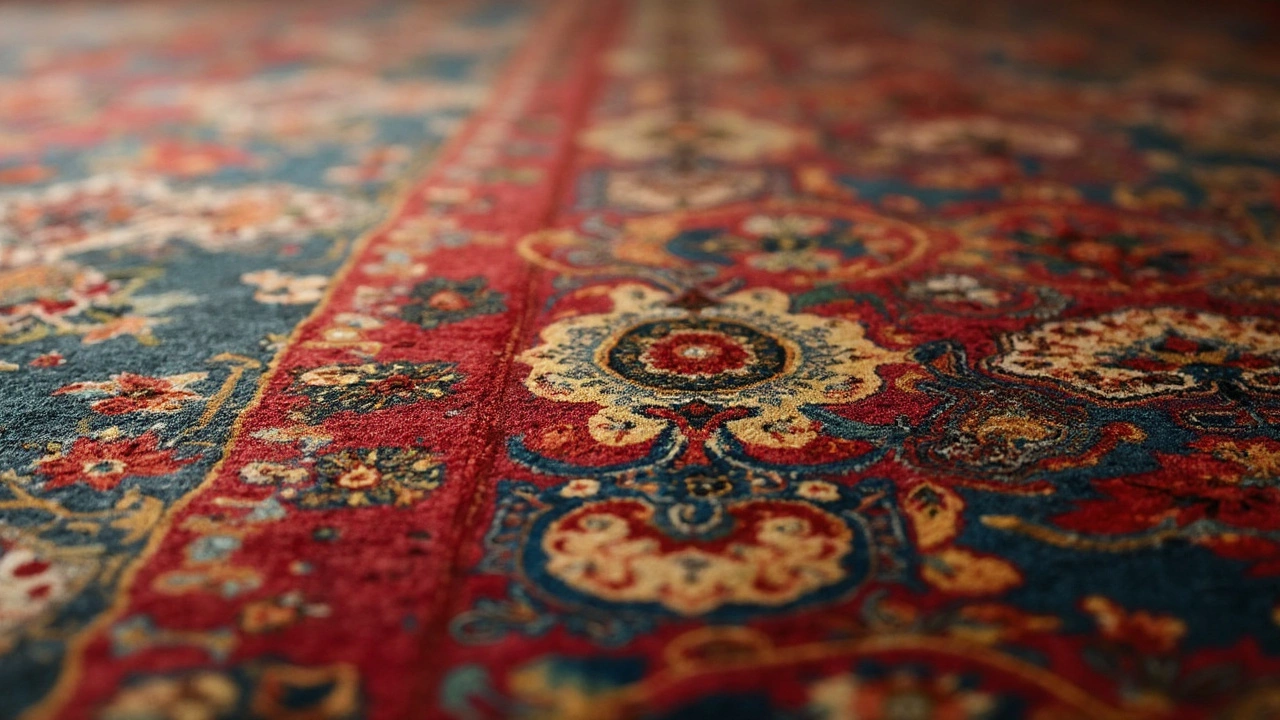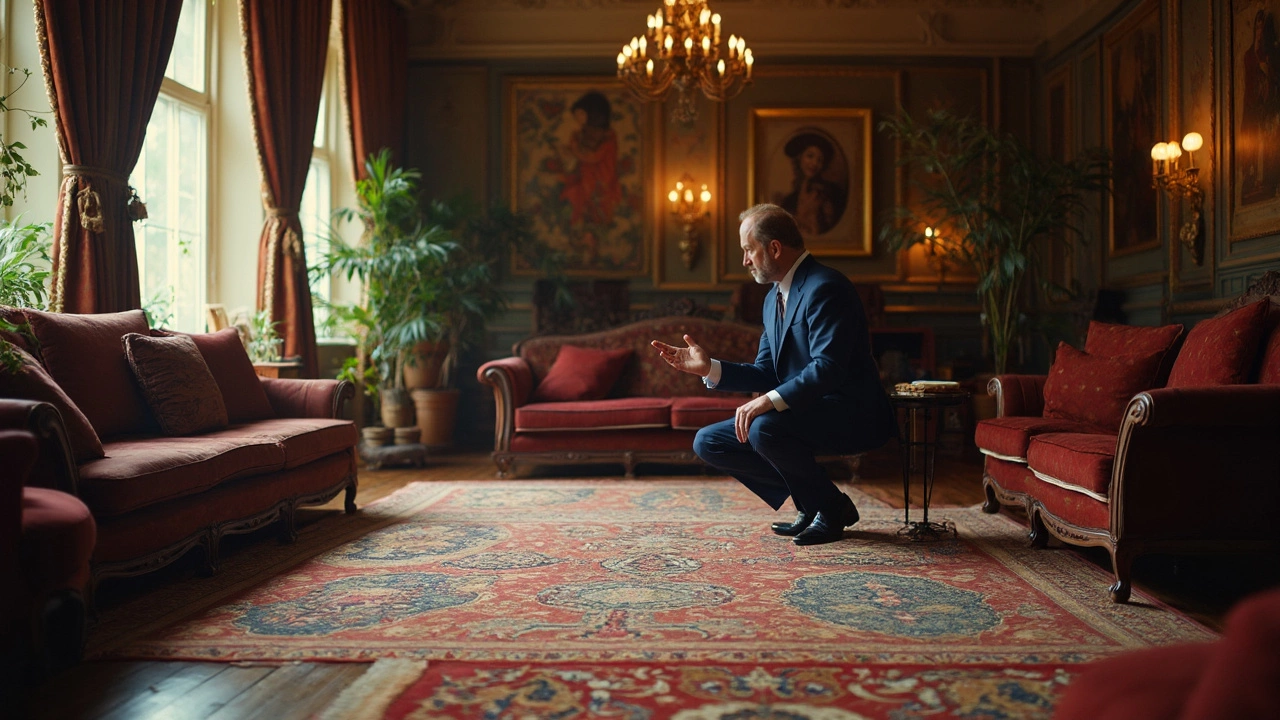How to Tell if a Rug is Expensive: Spotting the Luxe without a Price Tag
 Apr, 14 2025
Apr, 14 2025
Is that rug you’re eyeing worth the splurge, or is it just dressed up to look fancy? Knowing how to spot an expensive rug can save you a ton of cash—or ensure you’re investing it wisely. It’s not just about the price tag; it’s about the weave, the feel, the tale it tells.
Start with the material. Rugs handmade from natural fibers like wool, silk, or cotton usually signal luxury. That synthetic stuff? Likely not what high-end dealers are raving about. Wool’s durability and silk’s lush sheen are big giveaways that you’re handling something exquisite.
Next up, the craftsmanship. Flip that rug over as if you’re some secret rug detective. The density and precision of the knots are your clues. More knots generally equal finer quality. It’s like judging a book by its pages; more intricate equals more skill, more value.
- Material Matters
- Craftsmanship and Knots
- Colors and Dyes
- Age and Provenance
- Common Mistakes in Judging Value
Material Matters
When it comes to figuring out if a rug is on the pricier side, the material can speak volumes. The luxury in rugs often starts with the fibers, and certain materials are like gold in the world of weaving. The most sought-after ones are usually natural fibers like wool, silk, and sometimes cotton.
Wool is a rock star in the rug industry. It's super durable, naturally resistant to dirt, and even flame retardant, making it perfect for those looking for long-lasting luxury rugs that can take a bit of wear and tear.
Then there's silk, the real diva of rug materials. Silk rugs are all about sheen and elegance; they snag the spotlight with their brilliant luster and super soft feel. But, of course, this comes at a price—silk is way costlier and usually found in high-end pieces.
| Material | Characteristic | Common Use |
|---|---|---|
| Wool | Durable, flame resistant | Most rug quality pieces |
| Silk | Lustrous, elegant | High-end decorative rugs |
| Cotton | Affordable, breathable | Backing or low-end rugs |
Cotton, while not as glamorous, plays its part too. You'll often find cotton in the backing of rugs or as the primary material in less expensive options. It breathes well and adds stability to the rug’s structure.
So, when you’re on a hunt, trust your fingers and eyes. Feel the fiber, look for sheen, and maybe even dare to peek at the underside of the rug. That way, you can decide if you’re dealing with an expensive rug or one that’s just masquerading as such.
Craftsmanship and Knots
Alright, we’re getting into the nitty-gritty of what makes a rug scream 'luxury.' A big part of this is understanding the craft that goes into making it. Hand-knotted rugs are the cream of the crop when it comes to luxury rugs. Here's the scoop on why that matters so much.
Imagine each knot as a little investment of skill and time. Each strand is knotted by hand, often taking months or even years to complete a single rug. This isn’t some machine cranking out patterns at lightning speed. We’re talking about an artisan often spending a solid day to add just a few inches of knots.
Now, let's break down the basics. Rugs are generally measured by their knot density, which translates to how many knots there are per square inch. The higher the knot count, the finer the detail and design of the rug. Typically, a high-quality hand-knotted rug will have anywhere from 100 to 350 knots per square inch. Got a rug with over 600 knots per, and you might be holding onto something museum-worthy.
- Knot Density: A higher number of knots means a more detailed design and generally higher quality.
- Evenness: Consistent knotting indicates skilled craftsmanship. Uneven knots can sometimes mean the rug is a knock-off or poorly made.
- Back of the Rug: The design should be almost as clear on the back as it is on the front. This is a telltale sign of a well-crafted, hand-knotted rug.
One pro tip: Check out the finish on the ends and sides—these are called the selvedge and fringe. On an authentic hand-knotted rug, these are integral parts of the rug's construction, not just sewn on for show.
When you're evaluating rug quality, remember that intricate designs and complex patterns not only up the ante in terms of aesthetics but also signify a considerable amount of time and skill invested in making that piece.

Colors and Dyes
Ever wondered how to tell if a rug’s colors are genuinely luxurious? It’s all in the dyes. Authentic, expensive rugs often use natural dyes derived from plants and minerals, which give that deep, rich color you just don’t get with synthetic stuff.
Here's a simple trick: examine how the colors look. Natural dyes usually result in subtle color variations, giving the rug a unique character. Synthetic dyes produce uniform colors, like something out of a factory rather than hand-crafted magic. Ahmad the Rug Guy once said, "A rug with natural dyes will age gracefully, much like a fine wine."
"Natural dyes breathe life into rugs, allowing them to mature and develop unique hues over time." - Ahmad the Rug Guy
If you’re ever in a pinch to check, look for a sample swatch to do a colorfastness test. Rub a damp cloth over a small, inconspicuous area. If the color runs or fades, it’s likely synthetic. Quality rugs maintain their vibrant hues even when wet.
Fun fact: back in the day, some rugs used indigo and cochineal, which were luxury imports. These dyes were prized and revered, adding to the rug’s allure and value.
Keep these color and dye insights in mind, and you’ll have a much clearer picture when assessing a luxury rug without having to guess.
Age and Provenance
Let's dig into something really fascinating—how old a rug is and where it's from can totally up its game! Imagine stumbling upon a 100-year-old carpet versus one that's just left the factory. The history and origin, or provenance, of a rug can add layers of value that aren't immediately obvious.
Old rugs, especially those over 100 years, often fetch higher prices, not just because they're old, but because of their scarcity and the stories they carry. An antique rug from Persia or Anatolia? Now we're talking collector's dream! These regions, known for their distinct and sought-after styles, produce rugs that are like art pieces.
Spotting provenance can be tricky if you're not a seasoned rug buff. But here are some tips:
- Labels or tags: Some rugs have tags on the back with info on their origin.
- Design patterns: Learn about traditional patterns from famous rug regions. Tribal or floral designs can hint at where a rug was crafted.
- Expert appraisal: Sometimes, it's best to bring in the pros. A certified appraiser can give you the lowdown on age and provenance.
If you’re really curious, auction results can provide insights into what collectors pay for similar rugs, helping gauge if you're making a good investment. Here's a quick look at how age and provenance can make a difference:
| Rug Age | Potential Value Increase | Common Origins |
|---|---|---|
| 50-100 years | Moderate | Iran, India |
| Over 100 years | High | Persia, China |
So, when evaluating an expensive rug, give its age and origin some major attention. Understanding these aspects can unlock a whole new layer of appreciation—and value!

Common Mistakes in Judging Value
Getting tricked into thinking a cheap rug is a luxury rug is easier than you might think. Many folks misjudge rug value by focusing on the wrong things, and it’s kinda frustrating to see people falling for these traps. Let's demystify a few common blunders:
One classic mistake is assuming that a high price equals high quality. Some sellers slap a hefty price tag on just about anything to make it seem like a treasure. Authenticity checks, like material and craftsmanship, are way more telling than a price sticker.
Another pitfall? Ignoring the rug’s origin. Rugs from certain areas, like Persian or Oriental rugs, are often pricier because of their heritage and technique. If it’s a rug quality you’re after, knowing its roots can change the game completely.
Aesthetics over substance is a biggie. People get dazzled by patterns and colors; these are important but shouldn’t overshadow the details like knots-per-square-inch or fiber quality. Don't let a vibrant design distract you from potential flaws.
- Overlooking wear and tear: Some wear can actually add character, but too much means it won’t last long.
- Confusing style trends with timeless craft: Trendy isn’t always translate to good quality.
- Misjudging age without proof: Older doesn’t always mean more valuable; it has to be well-preserved too.
To help with understanding what really matters, here’s a quick overview:
| Mistake | Why it’s a problem |
|---|---|
| Price Focus | High price doesn’t guarantee high quality. |
| Ignoring Origin | Regional expertise can imply better quality. |
| Aesthetic Overload | Pretty design can mask craftsmanship flaws. |
Avoid these missteps, and you’ll be on your way to spotting genuine value in rug quality. Still, it helps to consult an expert if you’re really invested. They can offer insights that the untrained eye might miss.